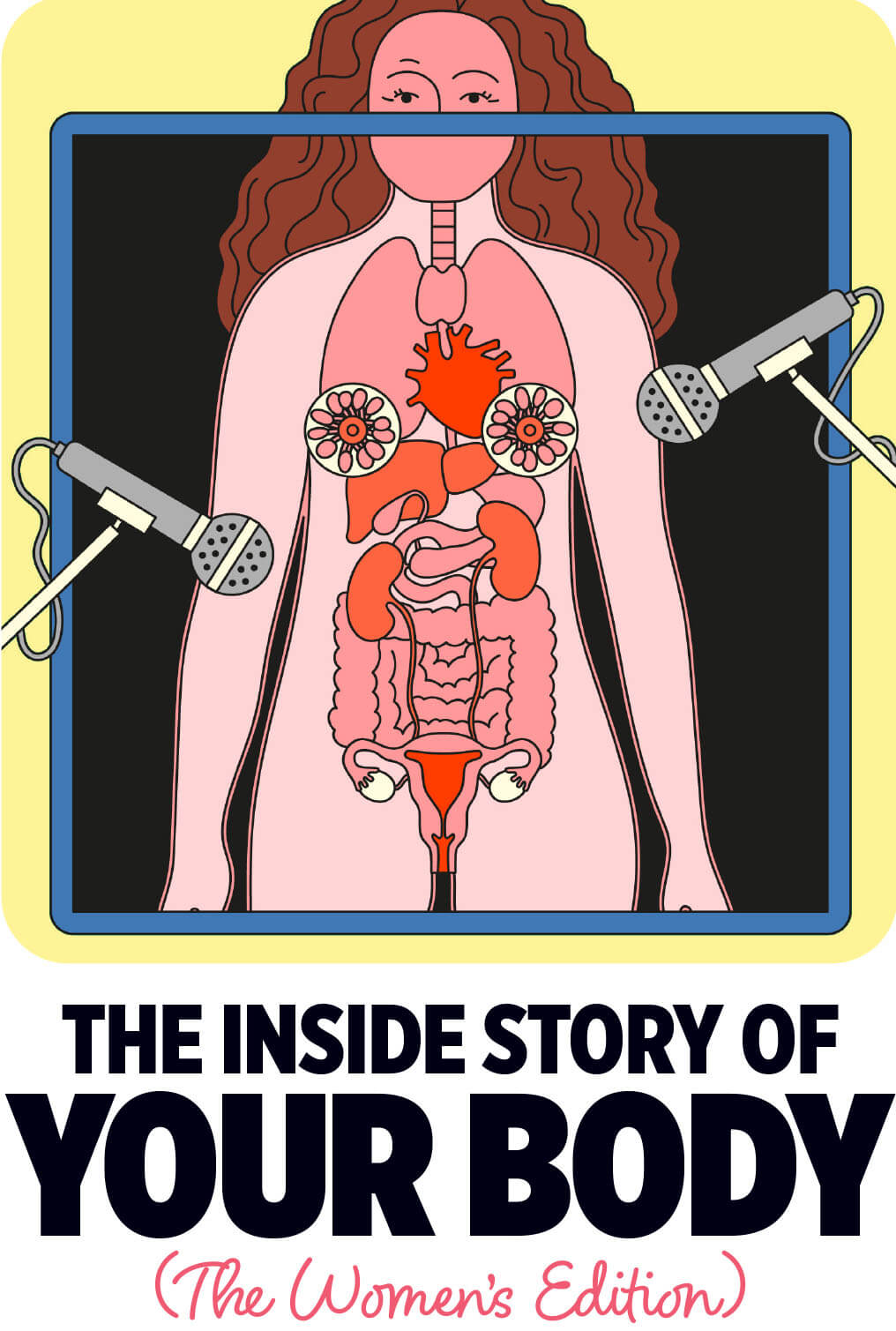
Female bodies change in confounding ways as we age. I decided to check in on how everything Down There is holding up, what we all need to know about healthy aging and who’s responsible when things go awry. (I’m looking at you, estrogen!)
By Judith Newman
ILLUSTRATIONS BY LAURA EDELBACHER
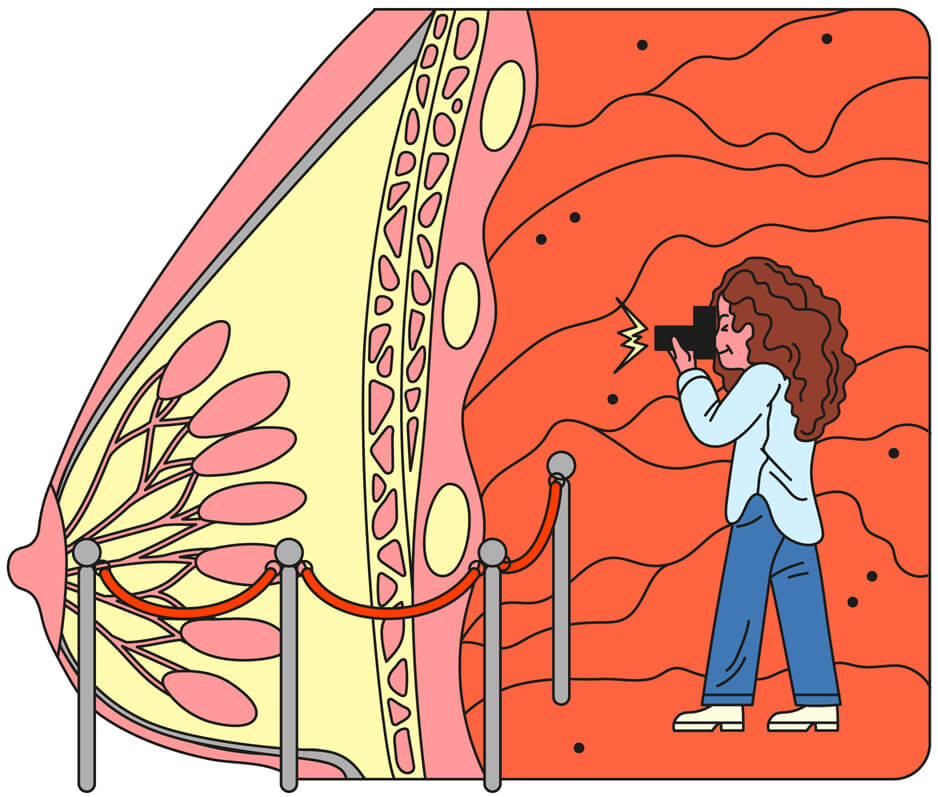
YOUR BREAST
The Headliners
Me: Of all of my parts, you’ve always been my favorite. Remember that time the guy at the liquor store refused to give me a refund because I didn’t have a receipt, so I returned in a fur coat with nothing underneath but a push-up bra and I got my money back? Good job!
Breasts: We do our best.
Me: Of course, I was a little younger then, and you were a little higher.
Breasts: A little? Ha ha. By the way, that bra you wear when you sleep? May not make the slightest difference.
Me: [Sigh.] I feel I know you only on the surface. What’s going on inside?
Breasts: We’re made up of three parts: the fibroglandular tissue—the lobes and the smaller lobules within them that produce milk, and the ducts that carry milk to the nipples; the fibrous tissue that holds us in place; and the fatty tissue—the space between the lobes, ducts and fibrous tissue that gives us our va and our voom.
Me: Women think a lot about the size of their breasts, but we should be thinking about more than size, shouldn’t we? There’s the question of, like, density.
Breasts: When doctors talk about our density, they’re referring to our relative amounts of connective tissue/glandular material versus fat. We breasts tend to be denser when a woman is younger. As you age, we become fattier, even if the rest of you stays the same size. There are extremes of fattiness and denseness (about 10 percent of women fall into each category), but most women are somewhere in the middle. Women with dense breast tissue throughout their lives have a higher risk of breast cancer.
Me: Why?
Breasts: No one really knows. It may be because small cancers are harder to catch early on in dense breasts, or it may be something about the nature of the tissue itself. Dense breasts are only one among several risk factors, including family history, radiation therapy for other medical conditions and, simply, aging. Also, you might want to be particularly vigilant if you’re Black or Latina, since you tend to present with breast cancer younger than white women—and with more aggressive cancers too. So while all of us breasts really appreciate regular mammograms, your dense breasts would probably appreciate them a little bit more.
Nipples: Excuse me, can we make a point?
Me: Yes, if I turn on the air-conditioning. I know, bad joke.
Nipples: FYI, we’re not just the conduits to milk. Nursing releases oxytocin, a hormone that conveys a sensation of pleasure and contentment to the brain. This is why nursing was a bonding experience with your child, and why many of us found it so sad when we gave up breastfeeding.
Me: But you can hurt like a mofo too.
Nipples: Yup. And as we get older, you need to pay attention to us: Pain, discharge or inversion of the nipples can indicate cancer. But we’re still playing an important role in your sex life, even after menopause: We connect to nerve systems that connect the clitoris, vagina, cervix and uterus to the brain.
Clitoris: Sing it, sister.
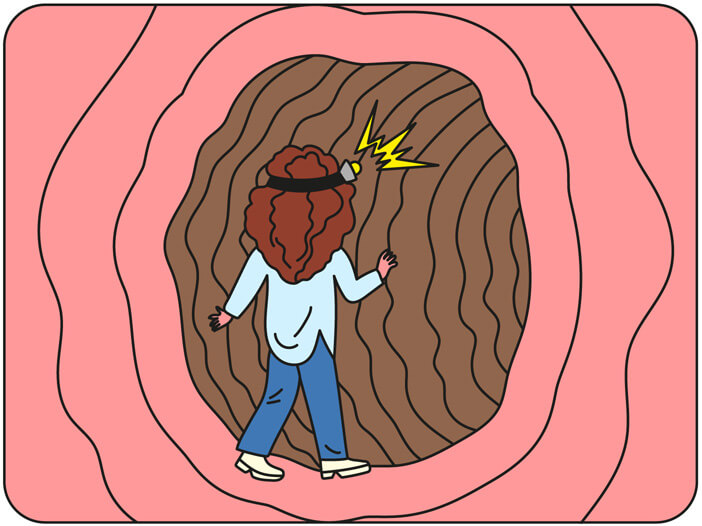
YOUR VAGINA AND CLITORIS
The Mystery Achievers
Me: Well, hello, Ms. Clitoris. I found you … when I was about 12, I think.
Clitoris: When you found that hidden copy of Our Bodies, Ourselves, like half of all American women who came of age in the 1970s?
Me: Um, it was a copy of Portnoy’s Complaint, but you have the idea.
Vagina: What about me? Am I not the most amazing body part?
Me: I can’t say I’ve actually looked at you too carefully. Can you give me the guided tour?
Vagina: During the reproductive years, I am this gently corrugated tube in the middle of your body that is so stretchy it can clamp onto a tampon, then when you’re pregnant, turn around and deliver a baby. A rich supply of blood vessels just under the surface makes me (barring infection or disease) self-cleaning, self-moisturizing and an all-around trouper.
Me: I’ve always heard the expression “use it or lose it.” Is that true? Does sex keep you in good shape?
Vagina: Kinda. Frequent sex stimulates circulation, enhancing elasticity and lubrication. But the main reason for all this moisture and elasticity is estrogen. Estrogen feeds the blood vessels in the walls of the vagina—and maintains the pH balance, which helps avoid vaginal infections. It keeps the lips of the vagina—the labia—plump, the pelvic floor muscles strong and the lining of the bladder elastic, meaning at 30 we don’t have to run to the bathroom every 10 minutes.
Me: [Sigh.] Things change.
Vagina: They do. With menopause, estrogen recedes like the ocean at low tide. The labia become flatter and less pink; that fabulous self-lubricating quality may cease, leaving sex feeling a little bit like rubbing two sticks together. The vaginal tissues can contract, pulling back from the urethra, which in turn leaves it more exposed to bacteria, and that means urinary tract infections may become more common. Urinary incontinence is also annoyingly common; about 43 percent of women 50 to 65 and 51 percent after 65 have had the experience of coughing or sneezing and then realizing, yikes.
Me: Is there anything a girl can do to keep her vagina in midseason form?
Vagina: Plenty. Regular Pap smears can catch any changes in cervical cells that, left untreated, could lead to cancer.
Me: [Shudder.]
Vagina: I know, Pap smears aren’t comfortable. Best to always ask for a smaller speculum. Kegel exercises (basically, squeezing those muscles that surround the vagina) can strengthen the pelvic floor and reverse urinary leakage. Estrogen patches and pills are mostly used to relieve symptoms like hot flashes, but for the vagina specifically, there are creams and suppositories that deliver estrogen almost entirely to the vagina alone. Or there’s the prescription cream DHEA, which breaks down into estrogen and testosterone. (There’s also a relatively new nonestrogen oral medication called Osphena, which specifically acts on vaginal tissues.) And then there are vaginal laser treatments, which essentially wound the interior skin, causing it to plump and fluff while it rebuilds collagen. (And yes, it hurts.) Plus, there are dozens of lubricants on the market. They work.
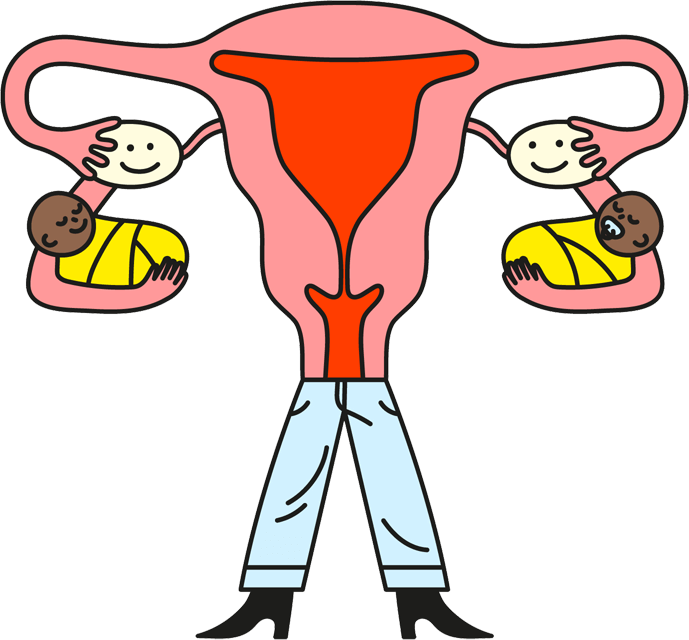
YOUR OVARIES
The Baby Makers
Ovaries: Vagina, schmagina! This whole perpetuating-the-species thing is really all about us.
Me: OK, what’s your story?
Ovaries: We are the organs that house a woman’s oocytes, or eggs. By the time you reached puberty, you had about 400,000. (Sounds like plenty, but consider that men have about 300 million sperm—in one ejaculate.) Infertility drugs can make the body produce a bunch of eggs at a time, but you are not getting more than you started with.
Me: What else do you do?
Ovaries: We produce the hormones necessary to release the egg and care for it if it becomes an embryo. And we produce testosterone, too, even after menopause, which helps protect bone mass and libido.
Me: I always thought it was Colin Firth who protected my libido. As long as we’re talking hormones: What the hell was PMS about?
Ovaries: Well, this isn’t an exact science, but PMS has to do with an upsurge in progesterone—which can have the side effect of making you very, very edgy—and then its sudden drop right before bleeding.
Me: That’s one thing about being young I don’t miss.
Ovaries: Yeah, but here’s the tough news: Ovaries are pretty much the first part of a woman’s body to show her age. In our teens and 20s, the chances of getting pregnant on any given cycle is about 25 percent. After 40, the chance of natural pregnancy per cycle is about 2 to 5 percent, which is why many women 40 and over seek out scientific interventions like IVF.
Me: I was 40 when I had my kids, through IVF, and the doctors referred to me as a “geriatric mother.”
Ovaries: There’s more bad news: Because it doesn’t cause obvious symptoms, ovarian cancer is often not detected until it has spread beyond the ovaries. Quitting smoking and maintaining a healthy weight can reduce your risk. But a lot of aging, including cancer risk, comes down to estrogen. We stop producing it almost entirely after menopause, which affects just about every system in the body, from the quality of the nails on your toes to the quality of your gray matter.
Uterus: For the love of God, is it my turn yet?
Me: Don’t be so hysterical.
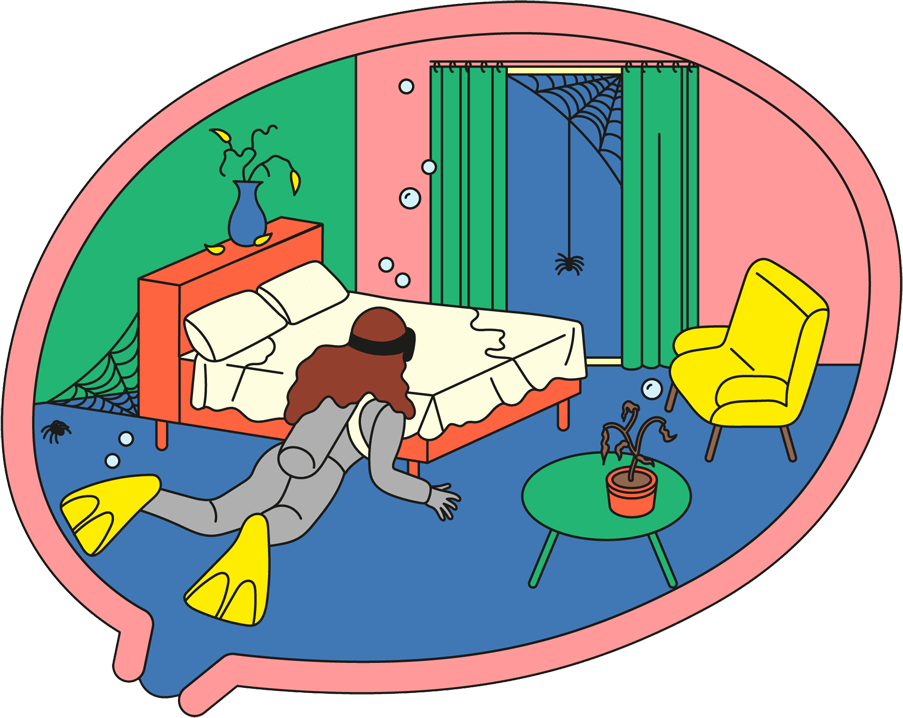
YOUR UTERUS
Airbnb for Babies
Me: See, the word “hysterical” derives from the Greek word for uterus, and a hysterectomy is …
Uterus: Yeah, leave it to a dude to link lady parts with craziness. But we are wondrous. Hollow and muscular (and sometimes tipped this way or that in ways that can cause sexual or urinary issues), I, the uterus, sit between your rectum and your bladder within your pelvis. (This explains the need pregnant women have to pee or poop more frequently.) The “doorway” connecting the vagina to the uterus is called the cervix, and the two tubes emanating from it that look like deer horns are the fallopian tubes.
My job is to grow babies and, the rest of the time, to at least be prepared. A surge of estrogen makes the lining of the uterus spongy and thick with blood as you near ovulation. If an egg meets Mr. Right and is fertilized, great: The embryo implants in the cushy lining, and pregnancy begins. If that doesn’t happen, my prepped lining just departs—that’s menstruation, which you spend 35 to 40 years bitching about.
Me: Until it stops. As Joni Mitchell sings, “Don’t it always seem to go / That you don’t know what you’ve got / Till it’s gone.…”
Uterus: Ahh, wiser words have never been spoken.
Me: Is there anything we can do to take better care of you?
Uterus: If you encounter bleeding and cramping after menopause, consult your doctor. For example, 70 percent of white women and 80 percent of Black women have fibroids, noncancerous tumors on the lining of the uterus. Often the fibroids just hang around and do nothing; you may never know you have them.
Fibroids: We’re heeeere!
Uterus: Sometimes they’re like that party guest who won’t leave, the one who drinks all your tequila and plays Kenny Loggins till 4 a.m.—they’re painful and relentless. And then there’s endometriosis, the growth of uterine tissue outside of the uterus (in fallopian tubes, ovaries and inside the pelvis). If endometriosis were a character from a movie, it would be Glenn Close in Fatal Attraction.
Endometriosis: I will not be ignored, lady.
Uterus: The excess tissue not only bleeds into your pelvic cavity but it can also cause irritation and scarring on other organs, or painful urination or bowel movements. Up to 4 percent of postmenopausal women may have symptoms. Treatment usually involves hormone therapy or surgery.
Me: Wow. So many women have these conditions, so the NIH must devote tons of money to researching them. Right?
Uterus: Uhhh … no. In 2023, just as a comparison, $92 million was devoted to Crohn’s disease, which affects 1 percent of the population. However, only $29 million was spent on endometriosis, which affects about 1 in 10 women, and $14 million was devoted to fibroids, which affect over 70 percent of us. But don’t get me started. The amount of money devoted to problems that only affect women is so often a fraction of the amount devoted to problems that affect men. OK, I’ll stop now.
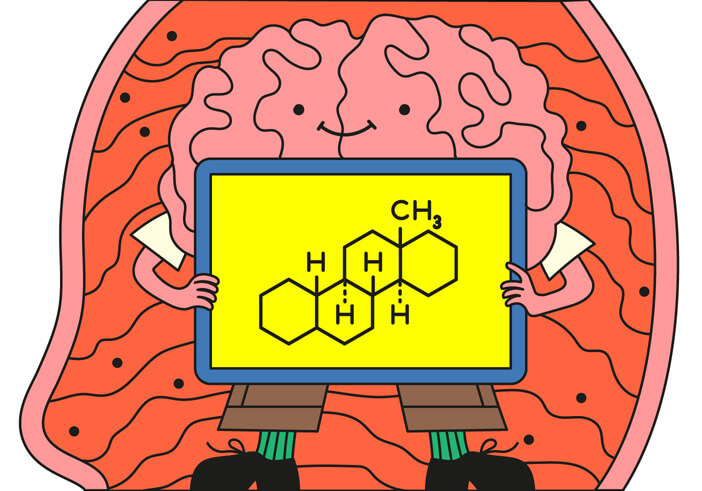
YOUR BRAIN
The Master Controller
Brain: Finally, we get to the important bit.
Me: Wait, who asked you? You’re not a lady part.
Brain: Au contraire. Women’s brains are fundamentally different than men’s, and I don’t just mean in that adorable Venus versus Mars kind of way.
Me: OK, how exactly are male and female brains different?
Brain: Again, it’s the estrogen. Estrogen is not just a hormone for reproduction; it also has a huge impact on brain function, particularly those areas that affect cognitive function and memory. Those hot flashes, the insomnia, the tendency to leave your keys in the freezer? Those are the effects of receding estrogen on certain neural pathways.
Me: Since menopause, I feel I’m on constant 10-second delay. I try to remember my third cousin’s name and ...
Brain: It’s Randall. This is normal. The info is still there. You just need a bit more time to retrieve it. Look, I’m like any other body part: You keep me healthy by feeding me well and exercising me. Ditch the processed foods and fake sugars; work up a sweat a few times a week (even social dancing has been shown to reduce the risk of Alzheimer’s); get regular and sustained sleep. And yes, do puzzles: Puzzles give you tiny successes, which then release hits of the pleasure hormone, dopamine, a key factor in reducing inflammation in the body.
Look at it this way. Those years of being bathed in reproductive hormones were exciting. But at the same time, the wisdom that comes with age may also have to do with having less of them. That bad boy who was so irresistible when you were 25? With less estrogen and testosterone, you might not see the appeal. Once you’re over 50, nice guys very often do finish first. Older and creakier? Maybe. Older and wiser? Fer sure.
To Replace or Not to Replace?
Girls, answer a question for me. Who thinks women in menopause should investigate hormone replacement therapy?
Vagina: Me.
Clitoris: Me.
Brain: Yes, please.
Heart: Definitely.
Breasts: Um, maybe?
Uterus and Ovaries: Heart, where’d you come from?
Heart: Whoops, wrong article. But still, I vote yes.
Estrogen may have health and symptom-relief benefits if taken at the beginning of menopause and for a certain period of time thereafter. But age and personal health history need to be considered. Ask your doctor whether estrogen replacement therapy is right for you.
Judith Newman writes frequently for The New York Times and other publications.